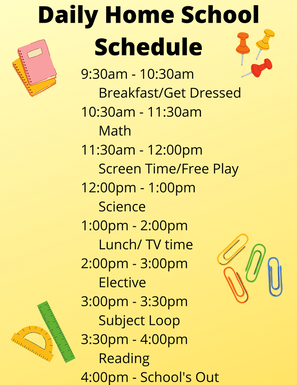|
It is almost that time again: Back to School! However, living in the Covid-19 age is not going to make going back to school for our little ones very fun. Some of you may be thinking about taking a different approach to this school year, such as homeschooling. Homeschooling your little ones can seem overwhelming at first, trying to get supplies together, finding a balance between work, homeschooling and housework, as well as make sure that your little ones are getting the attention and knowledge they need to succeed. Here are some tips to help you make sure that your homeschoolers are getting everything they need in their daily home school life. The first thing you need to do is come up with a yearly schedule. The standard number of days for a calendar year is 180 days or 36 weeks. Here are some ideas to creating your home school yearly calendar:
Please note that these are not all the possibilities to create your yearly schedule. Check with your state as well to learn about homeschooling laws, as they could have an affect on your yearly schedule. Now that you have established your yearly schedule, you need to create a weekly schedule. When considering your weekly schedule, make sure to include outside factors like co-op, work schedules, field trips, or errands. There are two types of scheduling that can be used to plan your weekly home school schedule: Block or Loop scheduling. Block Scheduling is done by setting a large span of time on a subject versus a few hours on that subject. For example, one week of school could be allotted for math and the next week could be focused on reading. This type of scheduling allows the student to focus on one particular subject at a time instead of five subjects squeezed into a single school day. Loop Scheduling is done by creating a list of activities that need to be covered, but no specific time frame or day to cover them. If you want to cover a range of subjects such as cooking, writing, music, art, etc. then you can schedule those activities on a loop. Working on the different subjects when that day comes in the loop. For example, you could have art class on Wednesdays, but run out of the allotted time for art class. That project would then move to the next “loop” day for the next time you have art class. Creating a schedule using both of these scheduling techniques in a great way to incorporate a well diverse schedule for your little one. Once you have established a weekly calendar, you can start getting down to the real work… the daily schedule. The daily schedule is, of course, what you will be doing each day with your kids. Please remember to check with your state laws to make sure there are no restrictions on a daily schedule for students.  Some things to consider when making your daily schedule:
The best part about homeschooling is that you have a lot of flexibility! If something comes up unexpectedly, trips, or even just needing a break earlier than expected, you can change what happens week to week or day to day in your homeschooling environment. As long as you are making sure that you are in accordance with your state laws, you have a lot more freedom with this type of schooling than you do with your typical school.
Below is a sample of a daily schedule that can help you get a head start on making your own daily schedule that works for you and your family.
0 Comments
Leave a Reply. |
AuthorArchives
April 2023
Categories |


 RSS Feed
RSS Feed
